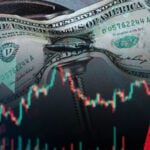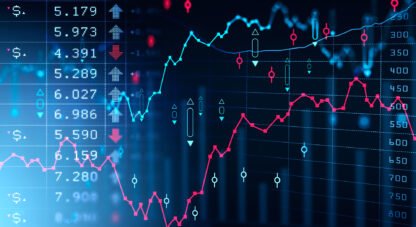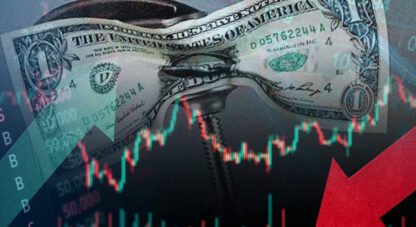Podcast: Play in new window
Disclaimer: Advisory services are offered by McAlvany Wealth Management, an investment adviser registered with the U.S. Securities and Exchange Commission. The comments made in this audio recording discuss economic and market trends and are not intended as advice for any particular investor. A short selling strategy involves a substantial degree of risk. Any decision to engage in a short selling strategy should be reviewed with your financial adviser. Past performance is no guarantee of future results.
Tactical Short 4th Quarter 2022 Recap
January 19, 2023
David McAlvany: Well, welcome. We appreciate your participation in our fourth quarter 2022 recap conference call. As always, a special thanks to our valued clients and account holders. We greatly value those relationships.
Before we get started, I want to turn your attention to our new website. There’s a couple of resources there that I think you might find helpful, mcalvany.com/wealth. When you’re at mcalvany.com/wealth, there’s some areas that I think you’ll use on a routine basis.
Market Insights is where you’ll find Credit Bubble Bulletin, Hard Asset Insights, and a few other resources. You can customize your own view to see the things that you want to see on a daily basis, and I highly recommend that you go there and take advantage of Doug’s curated newsfeed. You get to see what he’s reading on a daily basis, and know what we’re discussing as a team. And again, that’s the Credit Bubble Daily. Of course, he has the weekly, which is his recap. For those of you who have known Doug through the decades, that’s sort of his weekly magnum opus.
So again, Market Insights and you’ll find both the Credit Bubble Bulletin and other offerings informationally that might be helpful to you. If you’re interested in past calls and knowing what, over the last few years, we’ve been talking about on the Tactical Short calls, in that same section, Market Insights, Investor Calls, we’ve got a litany of calls for you to sort through there, and would invite you to indulge, binge read, all things credit, and all things Doug Noland.
Again, welcome. This afternoon, with first time listeners on the call today, we’ll begin with some general information for those unfamiliar with Tactical Short. And again, more detailed information is available at the mcalvany.com/wealth website.
The objective of Tactical Short is to provide a professionally managed product that reduces the overall risk in a client’s total investment portfolio, while at the same time providing downside protection in a global market backdrop with extraordinary uncertainty and with extreme risk. The strategy is designed for separately managed accounts. That allows us to be very investor friendly, with full transparency, with flexibility, with reasonable fees, with no lockups. We have the flexibility to short stocks, ETFs. We also plan on occasion to buy liquid listed put options. Shorting entails a unique set of risks. I think we’re set apart both by our analytical framework as well as our uncompromising focus on identifying and managing risk.
Our Tactical Short strategy began the quarter with short exposure targeted at 78%, and the target was held steady through the end of the quarter due to the highly elevated risk environment for shorting. The S&P 500 ETF remained the only short position during the quarter. Sharp rally began 2023 as we’ve seen this year launch. This is a reminder of why we do not encourage aggressive bets against the stock market. As we stress during each call, remaining a hundred percent short all the time—and that’s what you typically find with most short products, that’s how they’re structured—in our view, this is an example of risk indifference. While aggressive shorting is rewarding at times, the market over recent years has inflicted huge losses on the short side for those indifferent to risk. So we believe disciplined risk management is absolutely essential for long-term success, and thus we’ve structured Tactical Short to ensure the flexibility to navigate through even the most challenging market conditions.
So I’ll begin with a review of the fourth quarter and full year performance, then Doug will review market dynamics from Q4 and looking ahead to the current market environment. And finally, we’ll move on to Q&A. Many questions have already been submitted, and we’ll take each of those in the order we received them. If you desire to send something in as we present, feel free to do so. Email that to Ted, that’s [email protected], mcalvany.com. Ted will put that in front of Doug and I, we’ll do our very best to entertain you with our answers there.
So updating performance, Tactical Short accounts after fees returned negative 5.1% during Q4, the S&P 500 returned positive 7.55. So for the quarter, Tactical Short accounts lost 67% of the S&P’s positive return, and Doug will explore some of the differences here. I think this is a compelling reason to consider Tactical Short. As for one-year performance, Tactical Short after fees returned a positive 14.04%, and that’s versus the negative 18.13% for the S&P 500. So, Tactical Short returned 78% of the S&P 500’s negative return for the full year and 67% of the S&P’s positive return in this most recent period.
We regularly track Tactical Short performance versus the three actively managed short fund competitors. So first we’ll look at Grizzly. The Grizzly Short Fund returned a negative 7.35% during Q4. For the year, Grizzly returned 22.43%. Ranger Equity Bear fund, that returned a negative 5.02 for the quarter and a positive return of 16.59 for the full year 2022. Federated Prudent Bear returned a negative 6.91 during Q4 and a positive one-year return of 17.78.
So while outperforming during Q4, Tactical Short lagged the competitor’s returns for the full year. Tactical short has significantly outperformed each of the bear funds since inception. From the April 7th, 2017 inception through the end of September, Tactical Short returned a negative 34.72%, and that’s compared to the positive returns in the S&P during that period of time of 80%. On average, we outperformed those three competitors just mentioned by 2,677 basis points, or said differently, 27 percentage points outperformance.
There are also the popular passive short index products. The ProShares Short S&P 500 ETF returned a negative 6.94 for the quarter and positive 18.07 for the year. The Rydex Inverse S&P 500® fund returned a negative 6.91% during Q4 and a positive 17.56 for 2022. There is also the PIMCO StocksPLUS® Short Fund, which returned a negative 6.22 for the quarter and a positive 16.85 for 2022.
That’ll wrap performance. And Doug, I hand the baton to you.
Doug Noland: Thanks, David.
Hello, everyone. Thank you for being with us today. I’ll start with performance. There was one more in a string of quarters of extraordinarily unsettled markets. Recall that the Bank of England in late September adopted emergency QE operations to quell crisis dynamics that had erupted in the UK bond market. Contagion had spawned a spike in yields and liquidity issues throughout the global bond markets, and that certainly includes treasuries. 10-year treasury yield spiked to the high going back to 2008.
The Bank of England bailout proved a pivotal event for global markets. Importantly, the dependability of the global central bank liquidity backstop was confirmed to nervous market participants. With policy focus having shifted to a changing and also challenging inflation fight, the so-called Fed put had turned ambiguous. Following the bond scare and urgent BoE response, markets were assured that central bankers might talk tough on inflation, but they would not risk tightening to the point of sparking crisis. Confidence grew that central bankers had received the message.
Q4 was notable for global markets reversing away from risk-off. Having intensified for months, de-risking/de-leveraging dynamics were subdued. After peaking at 4.24% in October, 10-year Treasury yields were down to 3.42 by the first week of December. And after trading below 3,500 on October 13th, the S&P 500 was 17% higher at 4,100 on December 1st. Equities ground higher, dominated by volatility and notably choppy trading action. Importantly, financial conditions loosened significantly during the quarter, as evidenced by most risk indicators.
I closely monitor CDS, or credit default swap, prices, and that’s the cost of buying protection against various bond defaults. After ending Q3 at 108 basis points, the high since the March 2020 crisis, investment grade CDS prices were down to 77 by December 1st. High-yield CDS had collapsed 170 basis points by mid-December. Corporate credit risk premiums narrowed significantly. Emblematic of the banking sector, J.P. Morgan CDS dropped from 114 to 71 basis points. After ending Q3 at about 32, the equity’s volatility VIX index traded below 19 on December 2nd. And the dollar, a key facet of global risk-off, had dropped about 10% by late in the quarter.
It was a challenging period for managing short exposure. Definitely it was tricky. On the one hand, risk remained highly elevated. The Powell Fed was signaling some real inflation fighting resolve. There was Powell’s November 1st post-meeting press conference where his hawkish comments sparked a quick 3½% downside reversal in the S&P 500, along with a 20 basis point pop in two-year yields. There was also a series of developments that risked heightened systemic risk, including spectacular collapses at FTX and their subsidiaries, and downward spiraling crypto. Redemption issues surfaced for two large Blackstone funds, with ramifications for the boom and so-called private credit.
The economy was showing vulnerability, with mounting fears of a real estate downturn. And there was also serious deterioration in China. Concerns mounted for Chinese economic, financial, and social fragility. There was the alarming Chinese National Congress, with Xi Jinping’s dramatic display of absolute power. Tough language pointed to aggressive anti-West foreign policy and hostility towards Taiwan, with fears of rapid deterioration in US-Chinese relations.
In Ukraine, there were worries of war escalation, along with Putin’s threats and anti-West diatribes. And just today, close Putin ally and former president Dmitry Medvedev warned that Russia, if they were defeated in Ukraine—that may trigger nuclear war.
In short, myriad fundamental factors pointed to an ongoing high-risk backdrop. Managing a product that helps hedge investors’ market risk, I was reluctant to lower Tactical Short’s target for short exposure. That remains steady through the quarter. I did not, however, disregard the loosening of financial conditions. In response to the UK crisis, I adjusted how I was managing the band around target for rebalancing purposes.
We started Q4 with exposure somewhat below target. And following the Bank of England’s policy shift and resulting looser financial conditions, I widened the target band on the downside while tightening the band on the upside. This err-on-the-side-of-risk-management approach generally meant that we didn’t add short exposure on market weakness, but then reduced short exposure to rebalance back to target as the market rallied. I know this gets somewhat confusing, but it is a key to our unique management approach and helps explain why Tactical Short lost 67.6% of the S&P 500 return during the quarter, meaningfully below our 78% short target.
As I’ve explained in previous calls, most funds rebalance back to target daily. For example, the Rydex Inverse S&P 500® fund will buy or sell at the end of each trading day to ensure exposure is back to 100% for the next day’s session. This means during market declines the fund will be selling to ensure short exposure gets back up to a hundred percent, and during rallies the fund will be buying, reversing shorts, to get back down to a hundred percent. In volatile markets, this repetitive buy-high/sell-low rebalancing can negatively impact performance—what I have over the years referred to as the meat grinder. Tactical Short’s short exposure management process is specifically striving to mitigate the meat grinder effect.
During the Q3 call, I stated that our trading band for rebalancing likely created a small drag on performance during a quarter of weak overall market performance. While impossible to quantify, our rebalance approach boosted relative performance during Q4. For the year, Tactical Short returned 78% of the S&P 500’s negative return, right in line with our short target. I would, of course, prefer more gains, but it was another year without performance surprises. On average, we lagged our three competitor funds by 489 basis points. For comparison, in 2020’s strong market, where the S&P 500 returned 18.3%, we outperformed by an average of over 2,000 basis points, or 20 percentage points.
Over the longer term, solid performance in the short side, it depends so much on avoiding outsized losses. It demands discipline and a constant risk management focus. One of our competitors lost 43% in 2020 when the S&P returned 18%, and then gained less than 17% last year when the S&P 500 returned about negative 18. Another lost 41% in 2020 and made about 22% last year. The Tactical Short investment philosophy maintains a central focus on risk versus reward analysis.
From a fundamental perspective, we’re seeing our bursting bubble bear thesis come to fruition. I believe we’re early in what will prove a deep and protracted bear market. Still, from a comprehensive macro-analysis of credit policy market structure, speculative dynamics in the global backdrop, there has been no doubt whatsoever. We’ve been operating in a high-risk environment. Major short squeezes and market rallies tend to erupt quickly. And with markets so unstable, it’s just about impossible to differentiate routine upside volatility from the start of a painful squeeze.
And this is a key point, such an exceptionally speculative marketplace dominated by leveraged and trend-following speculation, derivatives and market hedging, it guarantees instability and short squeezes. This reality explains why Tactical Short has held the short exposure target meaningfully below 100%. In such an unsettled environment, a lower beta short portfolio offers a more attractive risk versus reward profile than high beta. I’m willing to accept some underperformance in down markets to avoid outsized losses during squeezes and bear market rallies.
Let’s segue to our preview of 2023. Markets have been in the throes of a major short squeeze in stocks, Treasurys, MBS, corporate bonds, and currencies, and it’s global. Last week we saw the Goldman Sachs’ Most Short Index surge 15.7%, the strongest weekly gain since coming out of the market crisis in April 2020. Last week’s squeeze offers a timely illustration of squeeze dynamics and the challenge they present to short performance. On average, our three competitors lost 5.32% last week in one week, about double the S&P 500’s 2.71% gain. Basically, one-week squeezes erase two-thirds of Tactical Short’s 2022 underperformance. It’s typical for a portfolio of commonly shorted stocks to gain double or even triple the S&P 500 advance during an intense squeeze. Keep in mind that large losses require aggressive buying to rebalance exposure back down to target, often compounding performance issues. Last week illuminates why it has remained the core of Tactical Short’s strategy to run a lower volatility short portfolio while avoiding individual stock short squeezes.
Now let’s shift to macro-analysis. There seems to be an abundance of market enthusiasm for the narrative that the war against inflation has been won, the Fed’s tightening cycle is quickly coming to a conclusion, and the economic environment prospects are somewhere between soft landing and mild recession. And I wish I could be as optimistic. Punditry and analysis typically follow market direction with market performance heavily influenced by underlying financial conditions. And the big story to begin the new year is this ongoing loosening of financial conditions that began in Q4. Squeezes can induce powerful bursts of liquidity and optimism. Buying related to the unwind of short positions and derivative hedges creates marketplace liquidity, liquidity that engenders looser financial conditions.
Moreover, this dynamic is often self-reinforcing as the specter of a squeeze typically spurs speculation and speculative leveraging. After all, being on the winning side of a squeeze is one of the more immediately rewarding speculative endeavors. Markets have received a shot of adrenaline from this cross-market squeeze dynamic. Some of the large macro funds posted strong 2022 performance with an index of macro hedge funds returning 14.2%. Popular macro trades last year included shorts in Treasurys and global bonds, US bubble stocks, European equities, the yen, and crypto. Not coincidentally, last year’s big winning macro trades have reversed sharply higher, inflicting losses upon poorly positioned funds to begin 2023.
The drop in Treasury yields has been instrumental. Market yields and the yield curve are said to be discounting imminent recession. Rate markets basically have Fed funds peaking at 4.88% for the Fed’s May 3rd meeting, only then to reverse course, with rates reduced to 4.39% by the meeting on December 13th.
I’m uneasy with the narrative of a bond market signaling impending recession. Financial conditions have loosened dramatically, and such loose conditions would typically hold recessionary forces at bay. It’s worth interjecting into the analysis that exceptionally strong US credit growth permeated throughout 2022. It’s the best-kept secret in macro analysis. At least through the first three quarters of the year, the banking system led a historic lending boom. From my analytical perspective, myriad speculative bubbles burst last year, yet the overarching credit bubble persevered. There are indications of tightening bank lending standards, with some waning momentum in bank, non-bank, and private credit lending.
That the great credit bubble is at an inflection point magnifies market squeeze repercussions. Importantly, with the credit system at such a critical juncture, a more sustained squeeze can function as a critical source of marginal liquidity. Rallying securities markets, associated loosening, and a bouncing confidence hold the potential to spur market-based credit growth, in the process extending overall lending and credit booms. This dynamic creates upside risk for both growth and inflation.
A Bloomberg headline from this morning: “Global bond sales off to record start of nearly 600 billion.” The bond market is too complacent about inflation risk. It’s worth noting that gold has surged almost a hundred dollars to start the year. Copper has already posted a double-digit gain, and other base metals are off to strong starts. The dollar has been weak, and more persistent dollar weakness would support commodities and import prices.
Wall Street, not surprisingly, of course, is eager to declare “mission accomplished” in the war on inflation. Surely, the Fed will be more vigilant, and the significant loosening of market financial conditions is exactly what the Fed was hoping to avoid. The market has been disregarding Fed messaging that policy rates will need to go above 5% and remain there for a while. Jay Powell has specifically stated that the Fed must not repeat the mistake of premature reversal of monetary tightening.
So, why would the bond market dismiss Fed communication and price for a 2023 dovish pivot? What does the market see?
I’m skeptical of the economy slumping into a deep enough recession this year to force a Fed pivot—not so long as financial conditions remain this loose. Wall Street’s bullish narrative misses the key point. I believe the bond market is discounting probabilities of some type of an accident forcing the Fed’s hand, much as the gilt crisis forced Bank of England emergency actions.
If the bond market was indeed keying off recession risk, this year’s early risk-on and loosened conditions would spur a backup in yields and reassessment of expectations for a dovish pivot. But if bonds are instead focused on accident risk, squeezes and speculative excess are viewed as integral to an accident prone market backdrop.
Think for a moment of enormous derivative hedging and speculative flows as a jumbo cargo vessel that attains momentum over time and navigates turns slowly. The Bank of England got the ship to begin reversing course, and now risk-on has gained velocity. This works somewhat to extend credit, speculative, and economic cycles. It boosts confidence, but this market mini cycle only postpones unavoidable post-bubble financial and economic adjustment.
Importantly, vessel direction works to dictate financial conditions. This alternating risk-on, risk-off thrust of tighter or looser conditions is overpowering Fed efforts to calibrate a measured tightening of financial conditions. Furthermore, central bank measures to avoid over-tightening and to thwart crisis propel risk-on speculation. The upshot, as we’ve been witnessing, is excessively loose conditions.
We believe the world is in an unsettling transition to a new cycle. One of higher inflation, new-found central bank focus on inflation risk, tighter monetary policy, market liquidity backstop uncertainty, higher market yields, larger risk premiums and hedging costs along with deglobalization and elevated geopolitical risk.
This unfolding secular change is problematic for asset inflation and bubbles. Indeed, we view last year’s bursting speculative bubbles as the opening salvo in what we anticipate will be ongoing financial asset instability and hard asset outperformance. There are greater and more systemic financial bubbles vulnerable to collapse. We question the stability of existing market and financial structures, and it could be this [unclear] that has 10-year Treasury yields at 3.40% in the face of extraordinary inflation and Fed tightening.
With my view that the bond market is discounting the probability of an accident, I’ll allocate time to exploring a few areas of fragility. According to BlackRock, $867 billion flowed into global exchange traded funds, or ETFs, last year. While down from 2021’s record $1.29 trillion, the scope of ongoing inflows is astonishing considering the market environment. A reversal of flows away from the ETF complex is a potential market accident with major ramifications. Mounting risk of a disorderly run should not be dismissed.
The hedge fund industry, they had some struggles and close calls last year. But the situation didn’t culminate into panic deleveraging, mass redemptions, or even an industry crisis of confidence. Certainly nothing compared to 1994, ’98, 2008 or March 2020. The derivative marketplace had a scare in September, but the Bank of England helped kick that unfolding accident down the road. The Bank of International Settlements warned of 65 trillion of global speculative leverage hidden in swaps derivatives. The unhiding was left for another day.
The key point: Things could have been a whole lot worse last year. Dollar strength spawned some market instability, especially in the emerging markets, but after the Fed turned hawkish in early 2022, it was reasonable to assume the ECB and Bank of Japan would drag their heels in reversing ultra-dovish policies. The yen’s steady and deep 2022 devaluation was beneficial for yen carry trades and global leverage speculation more generally.
The Bank of Japan clung to negative rates and yield curve control—policies that helped global liquidity during a period of concerted tightening. Bank of Governor Haruhiko Kuroda’s term concludes at the end of March. There have been signs that Prime Minister Kishida is ready to move away from Abenomics and what has been years of reckless central bank monetary inflation. A shift to more reasonable Japanese monetary management after years of negative rates and massive monetization won’t go smoothly.
At the ECB, normalization still has some ways to go. With a policy rate of only 2% and an $8 trillion balance sheet, conditions have remained loose. But already European periphery debt markets have shown acute fragility. Italian 10-year yields ended the year at 4.68%, up 354 basis points in 2022. Italian and peripheral bond markets have been recent beneficiaries of the squeeze and loosened conditions. But there’s no doubt that European debt could be part of a global de-risking/deleveraging market accident.
Going back to 2021, I posited that China risks were a factor in depressed Treasury and global yields. Dynamics in China parallel global developments. China’s historic apartment and real estate bubbles burst last year. Economic growth faltered, and crisis dynamics engulfed China’s huge developer sector.
Yet things could have been much worse. Importantly, China’s credit bubble was ongoing, with system credit posting yet another year of double-digit growth. China could avoid a major accident in 2023. I just wouldn’t bet on it. As an analyst of credit bubble dynamics, I could not be more alarmed by how things continue to unfold.
For starters, the widening divergence between ongoing rapid credit expansion and deflating GDP growth is ominous. China is locked in an extended terminal phase of credit bubble excess. Not only is credit expanding recklessly, the quality of underlying Chinese loans and finance continues to deteriorate. Expanding another 10%, Chinese bank assets surpassed $55 trillion last year, and now Beijing is forcing its bloated and vulnerable banking system to aggressively support insolvent developers, the troubled local government sector, and the maladjusted Chinese bubble economy more generally.
Systemic risk is expanding exponentially in China. Deepening crisis appears inevitable. A long list of aggressive measures has for now somewhat stabilized real estate developers. Meanwhile, cracks are growing for China’s seven trillion of local government financing vehicles—securities that have camouflaged risk while financing trillions of uneconomic projects. In any other country, China’s predicament would cause China to suffer a crisis of confidence in its credit system and economy.
But China runs huge trade surpluses, and supposedly still has its 3 trillion-plus international [unclear] hoard. While showing cracks, confidence holds that Beijing still has things under control. The autocratic government can dictate sufficient credit growth to avoid an economic downward spiral.
Moreover, Beijing retains the capacity to thwart a run on the renminbi, or so markets believe. Presently, China is somewhat the enigma wrapped in a riddle. The nation is in [unclear] COVID wave, huge wave. It’s unclear how long infections will depress demand and negatively impact supply chains and production. Beijing has abandoned Zero COVID while adopting aggressive stimulus measures. Stimulus will have an impact, and there’s surely pent-up demand that should help underpin a semblance of economic recovery.
But confidence in the future has taken such a hit that it will likely take years to fully recover. The deflating apartment bubble won’t reflate anytime soon, and it’s reasonable to assume waning global demand and a slowing export sector will also stir economic headwinds. The renminbi is fortunate to have such weak competitors.
Having witnessed a number of emerging market crises over the past three decades, China today has all the necessary ingredients. I don’t see how China can continue on this trajectory of ballooning non-productive debt and escalating systemic risk without currency issues.
Beijing has resorted to playing games with derivatives and state-directed bank renminbi support to mask resources expended for currency stabilization. For now, China’s currency is a beneficiary of the big global short squeeze, but if the impacts of stimulus measures disappoint, and financial fragilities continue to mount, I see the case later in the year for a renewed flight from Chinese finance and their currency.
And if the currency decline turns disorderly and Beijing appears to be losing control, there’s risk of a destabilizing crisis of confidence. Things turn sour after major bubbles burst—in asset markets, economic performance, the public mood, geopolitics.
This time last year, war in Ukraine wasn’t on the world’s radar. History will look back at Russia’s invasion as hastening de-globalization and fragmentation—the so-called new iron curtain. The world is being forced to choose sides, and the rapidly evolving geopolitical landscape is fundamental to new cycle dynamics.
As I’ve discussed previously, boom periods engender perceptions of an expanding global pie, cooperation, integration, and alliances. They’re all seen as mutually beneficial. Late in the cycle perceptions begin to shift, with many viewing the pie as stagnant or shrinking. Zero-sum-game thinking dominates. Insecurity, animosity, disintegration, fraught alliances, and conflict take hold. Risks are alarmingly high for ongoing deterioration and dangerous geopolitical developments, and the fraught geopolitical backdrop needs to be included when discussing the bond market pricing probabilities of an accident.
Xi Jinping seems hell-bent on taking Taiwan. The US and West will step up military support, which increases the chance of an accident. Right now, China appears to want to ease tensions. I believe it’s a shift as part of Beijing’s crisis management focus on its deflating bubbles and sinking economy. But with Taiwan and trade tensions likely to escalate, I expect Beijing’s stab at playing nicer in the sandbox to be short-lived.
From geopolitical, financial, and economic perspectives, China is at the epicenter of an extremely high-risk 2023 backdrop. China’s bursting bubble economy is in serious trouble. Beijing will employ extraordinary fiscal and monetary stimulus, while directing its colossal financial sector to expand lending and liquidity support. Importantly, China’s dogged pursuit of global superpower status insures policymakers will reject the premise that deep economic contraction is an unavoidable facet of post-bubble financial and economic adjustment.
The upshot is extraordinary uncertainty. Does the China downturn unleash deflationary forces, or might another year of massive Chinese credit expansion underpin global inflation dynamics? Could an unstable Chinese currency unleash global currency instability? Does Beijing use Taiwan—the issue of Taiwan—to distract its disillusioned population? Might war escalation in Ukraine see China offering more direct financial, economic, and military aid to its Partner Without Limits? How would the West respond? Key questions that we just don’t have answers to today.
There are major uncertainties here in the US as well, relating to inflation, growth prospects, debt ceiling negotiations, tight labor markets, vulnerable real estate, political paralysis, and so on. Until I see more convincing evidence of a credit slowdown, my analysis will err on the side of robust wage growth, stubborn inflation, and some economic resilience. The Fed’s job only gets more challenging. While seeing inflation data on an encouraging trajectory, inflationary risk factors will remain highly elevated.
For now, loose financial conditions, strong credit growth, and tight labor will keep Fed officials from relaxing. Recall that 10-year Treasury yields were at 13-year highs just three months ago. De-risking/deleveraging was at the cusp of a precarious seizing-up of global markets. Derivatives markets were hanging in the balance. Italian and European bond markets were at their brink. Emerging market contagion risked a domino collapse, while risk of a destabilizing run on the ETF complex was rising.
Currency markets were turning disorderly. That, coupled with spiking yields, risked unleashing havoc for the global leverage speculating community. I don’t believe global de-risking/deleveraging risks have just melted away. The world is only about an upside inflation surprise away from panicked central bankers and a major bond market reassessment of inflation and policy tightening. And the short squeeze and risk-on backdrop to start the year could come back to haunt system stability.
A lot of money will come into the market on the perception that the storm has passed. The speculator community will cover shorts and become more aggressively long the markets. Hedges will be unwound, leaving a marketplace vulnerable to a panicked effort to reestablish hedges in a deteriorating market environment.
I certainly doubt we’ve heard the last of liquidity issues. Risk-on short covering and speculative leveraging create the illusion of liquidity abundance, and loose financial conditions will ensure the Fed continues to shrink its balance sheet, increasing the likelihood of liquidity problems erupting during the next serious bout of risk-off.
I really wish I could be less negative, but I believe we’re still early in what will be painful post-bubble financial and economic adjustment. Most still see the world through the prism of the previous cycle. Deeply ingrained foolish optimism endures. Confidence remains high that central bankers and Beijing have everything under control, but their control is superficial. It’s made possible by ongoing historic credit excess and risk-embracing financial markets. Policymaking turns much more difficult when credit downshifts and markets turn sour. But if excesses persist, expect more inflation and higher market yields.
I fear the unfolding new cycle could be characterized by crises of confidence in policymaking, the markets, financial structure, and economic prospects. I will adjust this view if I see—particularly in the US and China—slower credit growth unfold without corresponding financial, economic, and geopolitical instability.
In the meantime, my analytical framework will be focused on post-bubble dynamics and the likelihood of instability, negative surprises, and accidents. Be prepared for a year of dramatic swings in sentiment, and keep in mind that even very bearish fundamental underpinnings can be temporarily masked by risk-on market dynamics and loose financial conditions.
David, back to you.
David: Thanks Doug. Would love for each of you to do some quick back-of-the-napkin math, just on a piece of scratch paper. Jot down your current equity exposure is. This could be mutual funds. This could be individual stocks. And if you’ve got that tally in mind, I would really encourage you to consider having between 10 and 20% of that equity exposure hedged using Tactical Short.
We’ve had a first major leg down. 2022 was a really interesting year, S&P, NASDAQ, all of your major indexes under pressure, and we’ve got a relief rally here. This is the timeframe where, if you are not hedging your equity exposure, you’ve been given a gift. And if you’re not actively engaged with it and grateful for that gift, I think you’re missing something significant.
So, again, just look at your equity exposure, and consider hedging 10 to 20% of that using Tactical Short as the tool to do that. We want to work with you. We think that this is a compelling time to be managing risk. And we are part of that equation for you. You have risk in the marketplace, and this is obvious, most obvious in a year like 2022, where there’s really no place to hide. And you have some time, but I don’t think you have a lot of time to get things positioned in this regard, and have a little bit of your downside guarded against, protected against.
Anyways, we’ll move to Q&A, but I do want you to consider that a lot of the things that Doug has just shared with you, from a fundamental perspective, are not quickly or easily resolved. From a technical perspective, which is something that we often look at as well, you can see the putting in of a major market top. And what we had in 2022 does not represent resolution. It represents the first leg down in a significant and extended bear market.
And again, I just think that if you will take the time and do that simple back-of-the-napkin math, you should be in touch with our office in the next week and we can very easily get an account open for you and have that hedge position in place for you. I don’t think there’s anybody better in the business to be actively managing risk on your behalf than Doug Noland.
I invited you earlier to look at the refreshed website, those resources there, not only the weekly Credit Bubble Bulletin that many of you are already familiar with, but I can’t impress upon you the importance of knowing what’s going on a daily basis. And Doug does a tremendous amount of work in curating that list of articles that we’re reading, whether it’s the Financial Times, the Economist, or the Wall Street Journal, or CNBC, or Reuters. You could spend hours scouring the news outlets to find that information, and instead you get to spend minutes. So please take advantage of that and get familiar with the new format of the website, so you know just where to find those resources on a daily basis.
Let’s go ahead and go to Q&A. Thank you for your patience.
Doug, the first question to you is, “Does the strategy,” which will be profiled, which we’ve just talked about, “have a performance track record, for example in 2022?”
Doug: Yeah, I’ll answer that just in a second, David. Also, you were so kind, if there’s anyone on the call that is unfamiliar with David’s and Kevin Orrick’s Weekly Commentary, you’ve got to get familiar with it. It’s the best podcast around. And I also want to plug Morgan Lewis’s weekly Hard Asset Insights on the McAlvany website. Morgan does a great job every week, so please take advantage of that.
David, to answer the question, yeah, we strive for complete transparency. I don’t know anyone else that goes through and highlights competitor performance, especially if they’re being outperformed for a period. But we want complete transparency. We take a deep dive into performance, as I just did, in every call. We have all the past quarterly conference calls—audio recording and transcripts—available on the mcalvany.com website. And any other past performance data is available on request. Again, we want this to be complete transparency so everyone’s comfortable with strategy, the investment philosophy, and how we’re doing.
David: Next question’s from Danny. “We’re told that central banks have been acquiring significant quantities of gold. How reliable are the amounts being reported? And how do they compare to previous inflationary times?”
Well, that’s true. There is a global response, in 2022 in particular, a global response to the US dollar being weaponized. And that has included an increased allocation to gold by many central bankers. And this is not just inflation that people are thinking of, and I think this is a really key distinction. The reason is not primarily to balance inflation risk across fiat currency portfolio in terms of reserve assets. The 2022 motivator was seeing—and this is a global audience looking at US policy initiatives—seeing Russian US dollar reserves, totaling over $300 billion, they were nabbed by the US Treasury. So Russia no longer has access to those reserves. And so this brings to mind, for many central banks, reserve control, which is compelling.
To what degree do you have control of your reserves, and thus of your financial flexibility? So this reallocation to a tangible, physical, and liquid asset checks a lot of boxes for central banks, who are looking and saying, we just want to remain viable in our decision making. But if reserves are not domestically held, that’s the evidence of 2022, they’re less secure. That’s the view following the 2022 geopolitical events.
And I just think it’s important to linger on that a bit, because certainly inflation was a factor last year. But the motivating factor, particularly at the periphery, if you’re looking at the smaller central banks, these are central banks that don’t necessarily see themselves with a direct loyalty to the US, US foreign policy, or our prerogatives around the world.
So to the degree that we continue to see that as an expression of de globalization, and maybe a move away from US prerogatives, thinking again from a foreign policy perspective, I think you’ll continue to see the insulation of reserve assets by central banks.
The World Gold Council tracks official purchases and flows from depositories and storage facilities globally. And I think the World Gold Council’s numbers are good. Sometimes central banks can obscure some purchases, and there’s even been speculation that China’s numbers are partially accurate. They report what they want, when they want, and the assumption being that demand is perhaps larger than reported. That’s possible. By and large, the World Gold Council numbers are helpful in answering that question.
There is— The next question’s on inflation. I’ll take a stab at that one too, Doug, and then hand the mic back to you. “How does Wealth Management count inflation? How does that help guide investment decisions? Is it as simple as using John Williams’ Shadow Stats, or do you nuance John Williams’ information and include some combination of that with currencies priced in gold? Is credit a part of this conversation, with Doug Nolan bringing that into focus?”
So, yeah, obviously CPI and PPI are at the center of any conversation. They are useful, and part of the reason we have to pay attention to them, and we do pay attention to them, is they’re part of Wall Street economic assumptions. They’re part of every macro view, so they can’t be ignored. But we do have additional discussions about the impact, from hedonic adjustments, from shifts in weighting of the various components within the basket that make up CPI and PPI. And of course, we look at the substitutions and changes to methodologies where some of these things are changed. And this month is a perfect case in point, where we have a new methodology being put into effect by the Bureau of Labor Statistics.
The Unilever CEO comments earlier this week I thought were fascinating. His comment was basically that inflation had peaked, but that prices were continuing to rise. If you think about that, that’s the reality. Consumers are going to track price levels at a higher level and for a longer period of time, well after the Bureau of Labor Statistics has issued it’s all clear for the worst being in the rearview mirror.
And so, again, think about that. Inflation has peaked, but prices will continue to rise. That’s right, because statistics are now in the massage mode, and the methodology shift for January has a decidedly “deflationary” air to it. In other words, it’ll be bringing that rate down, which is helpful to many narratives. Under the component in that question, pricing all things in gold and in gold terms, I think that is a useful exercise over a multi-decade period.
I don’t think it’s as helpful in real time because the metals price can lag. It can lag for months, it can lag for quarters, or even years. Over a longer period of time, you can see the purchasing power of gold being upheld in the devaluation of currency as you see things priced in gold. So that’s very helpful.
And one of our friends, I think if you’re not familiar with pricedingold.com, a very bright gentleman with a history of patent creation, and he is just very quantitative in all the things that he does, manages a site which you should be familiar with, pricedingold.com.
Credit, to your point on credit, credit is a part of the conversation on two fronts. On the one hand, you have asset price inflation, which is connected to credit expansion. But I think it’s also fair to say that the expansion of credit is today’s version of an expansion in money within the system. What used to be limited to currency and circulation is now almost less important as we operate on a largely digital basis in a largely credit oriented system. I don’t know if you, Doug, want to add anything to that? Feel free.
Doug: No, that was excellent, David. Just my perspective, it’s more the Austrian school where if you have credit inflation or if you increase credit, that’s creating purchasing power. So you have inflation, then you just try to identify where the inflation is going. It could be asset prices, consumer prices. And a lot of the effect of credit inflation we’re seeing is just disorderly prices, just wild swings in prices. So inflation and credit inflation, not a complex issue, but key to announce this today and going forward.
David: Next question’s from Michael. He asks, “How is the growing US debt going to impact capital investment in the next several years?”
Doug: Interesting question. US debt numbers, they’re nothing short of astonishing. Perhaps scary is more accurate. And I’ve been taking a deep dive into each of the Fed’s quarterly Z1 reports, their flow of funds reports, for 25 years now. And it has been incredible to analyze one of history’s greatest credit bubbles unfold over the past couple of decades. And never did I think it would get to this point with US non-financial debt at about 70 trillion.
And this debt has surged almost 14 trillion, or 26%, just since the start of the pandemic. And here’s the debt growth that really blows me away. After ending 2007 at six trillion, or 40% of GDP, Treasury debt is now 26½ trillion—over 100% of GDP. I never imagined the bond market would tolerate such reckless deficit spending, but then I never contemplated, or at least early on I didn’t contemplate, the Fed would ever monetize five trillion of debt in 10 quarters.
And it’s a long discussion to explain how much of this unfolded without a surge in consumer price inflation. The short discussion is, the world is in this new cycle where inflation is now a very serious issue that demands intense focus and a shift in policy regimes by the Federal Reserve and global central banks. It was interesting to see the UK bond market revolt against Liz Truss’s tax and cut in spending—the so-called mini budget.
This was the initial warning shot to profligate politicians around the globe. And the September yield spike seems like a distant memory now that yields are sinking, but in no way do I think we’ve seen the last of inflation problems, nervous central bankers, and rising market yields.
So I think we’re late in the game of massive debt growth at low yields. It’s going to be significantly more expensive to borrow for capital investment. And as system credit slows, I expect intense pressure generally on corporate profits, which will also weigh on capital investment.
When I look at the greater technology sector, I already see this new-found post-bubble focus on cost cutting, spending restraint, that will surely have a major impact on at least that sector’s capital investment. But at the same time, there will be sectors with robust capital investment. Defense spending, renewables come to mind. I expect an ongoing push to be more self-sufficient as a nation, which opens the door to significant—and we’ve already seen the press releases—huge investment in semiconductors, and we’ll have more investment in battery technologies, rare earth metals, manufacturing more generally, all of that.
And it’s been a while since there’s been talk of the old crowding out effect. Washington is trapped in massive deficit spending, and when the bond market belatedly imposes some market discipline, and finance truly tightens, it truly tightens, I would expect less finance available for private sector capital spending. That’s kind of a long-winded answer there. While capital spending will— it’ll likely hold up pretty well this year. It’s difficult for me to be constructive over the next several years. And thank you for the question.
David: The next question I think was asked by someone who will not be listening to the answer. It is just: “Is the recording of the call provided for replay for those unable to attend?” Yes, it will be. That’ll be available in 24 hours. Transcript is usually ready within 72. I would just encourage you to take either of these and forward them to friends and family for a healthy discussion on the state of the markets.
We looked at the 8% decline of the DOW, the 19%—roughly—decline of the SMP, the one-third decline in NASDAQ, and in the equity indices this last year. And I think if you’re able to help guide a discussion here in early 2023, you’ve got friends and family who would deeply appreciate the insight.
So again, the call’s available 24 hours from now, transcript will be available within about 72 hours. Feel free to forward that along.
David asks this next question, “When does—” That’s not me, a different David. “When does the immense global debt become a critical issue that triggers a financial crisis? There has to be severe consequences of 35 years of Fed and other central bank reckless monetary policies.”
Doug: David, it doesn’t seem fair that you get the answer to the question about “is the call recorded,” and then you send this one to me.
Okay, so, as I discussed in my presentation, we were approaching a day of reckoning moment in late September before the Bank of England’s crisis response. De-risking/deleveraging was reversed, and now we’re back to risk-on with all these delusions of endless liquidity and central bank backstops.
And we’re already seeing strong corporate debt issuance and a surge in confidence that could support another year of huge late-cycle bank lending. But this is a ticking time bomb. The current debt structure doesn’t function well in a rising rate environment. And I think inflation has taken root, and credit is going to have to slow to get pricing pressures back under control. There’s Goldilocks’ fantasy spell that has taken hold in the markets. It’s going to be short lived.
The Fed has more work to do. And globally, the ECB has work to do. The Bank of Japan, they have to end this crazy money-printing market manipulation. China, as I discussed, has an epic challenge ahead to reign in bubble excess while thwarting system collapse.
Crisis dynamics, they take time to materialize. And the exact timing, it’s unknowable. It’s unknowable, especially in these times with contemporary market structure. We get this ebb and flow, risk-on, risk-off, exacerbated by derivatives and speculative flows. We just don’t know when a risk-off will reach the precipice and not recoil when deleveraging leads to panic and dislocation rather than a great dip buying opportunity. I tend to see the instability, uncertainty that we’re seeing associated with risk-on/risk-off, it’s working as this wrecking ball, it just chips away. Chip, chip, chip at confidence and system stability.
And I also believe every central bank bailout, certainly including the Bank of England’s, ensures only more debt, speculative excess, and leverage, and vulnerability to systemic crisis. Systemic risk, it just keeps growing. I suspect it’s compounding. I fear the consequences from the past 35 years are currently coming home to roost, and will haunt us throughout the new cycle, most unfortunately. But thank you for the question.
David: The things that seem to be real challenging with this quantity of debt that’s been accumulated over 35 years is that on cheap terms it’s manageable. It’s when rates rise that all of a sudden we realize the untenable nature of 35 years of accumulation.
Pete asks the next question, is it still a good time to buy silver and gold? Yeah, I do like being able to ask the questions, Doug, because then I can pick and choose— take the easy ones. To me, Pete, as an insurance policy, it is a good time to buy. Frankly, I think it’s always a good time. As an opportunity for growth, I think you can throw a different lens on gold and silver at different points. So as an insurance policy? Yes. As an opportunity for growth right now? Yes. Silver has perhaps more upside. Gold is now less than 10% from all time highs, which I expect to be surpassed this year. While silver has a hundred percent gain to recover to the global financial crisis era highs. There’s a lot of headroom for the silver market.
And I think that price level, too, will be taken out. Whether it’s this year or next, I don’t know, but I like gold as a hedge for systemic vulnerability. I also like gold as a hedge—we sometimes think of it as stupidity insurance, Washington DC policy making stupidity insurance. And that’s one of the reasons why I would say, yep, it’s always a good idea to have a few ounces, because there’s some really ridiculous things that come out of that part of the world.
So if that’s helpful, I think, yes, I would say that we’ve got an opportunity over the next month or two, where perhaps pricing is a little bit better. But if I’m looking at the end of year 2023, these prices you would be happy with.
Next question is from Jonathan. “Given the historically significant debt levels at the US and other countries being at an inflection point where the US and G7 countries can no longer meet their debt payments or obligations—” What I think he’s asking is if we are at that inflection point. “If so, what does this mean for the dollar? And how does it impact the standard of living here in the US?”
Doug: Yeah, great question. I’m going to sound like a broken record here, but I guess I’ve never let that stop me in the past. So I do, I believe we’re at a critical inflection point right now. So much debt has accumulated in the US and globally. In that sense, the great financial crisis below— or before the great financial crisis, and especially during the pandemic, systems are today vulnerable to a disorderly spike in yields. And this spike in market dislocation was unfolding, again only several months ago. Yields have dropped significantly on the view that the inflation storm has passed, and that tightening has almost run its course.
If this market view proves too optimistic, which I certainly believe it will, I think markets will face severe instability. There’s just so much debt, speculative leverage, and derivatives hedging. And it all creates vulnerability to illiquidity, market dislocation, and panic.
So the view holds that major governments will never default on their debt obligations. In the event of a crisis, central banks will simply monetize debt, government debt in particular, to ensure payments are made. But what if surging inflation limits the amount of debt central banks can purchase without unleashing hyperinflation dynamics? What if central bank monetization unleashes a panic run out of a currency?
Markets are today way too complacent when it comes to risks associated with central bank monetization. As I mentioned earlier, we’re transitioning to a new cycle of higher inflation, and much less central bank flexibility. And this has major ramifications for government debt markets and market yields. Now, I can’t help but to believe we’re heading towards a major crisis of confidence in policy and market structure. And this will have a major negative impact on our standard of living. I expect it also to have a major impact on the dollar, although all the major currencies are unsound and vulnerable. And that helps explain why we are such big fans of the precious metals and hard assets. And thank you for your question.
David: Thomas asks, “Is there one more short drop for silver before it moves higher?” We don’t have a crystal ball. And I think, on that basis, dollar cost averaging is not a bad idea. But let me say this: When the price dropped last year—of course we finished basically flat for the year, but there was some downside volatility—when the price dropped last year, our sister company, McAlvany Precious Metals, 50 years old as of 2022, we were able to increase silver ounces and the exposure for clients between 40 and 50%. And I would just encourage you to think about, first of all, a long-term relationship. Secondly, a long-term strategy for compounding ounces. And lastly, just a track record that goes back five decades, which I think is more important than picking up silver a dollar or two cheaper.
There’s things that we can help with, our sister company can. Premium trades, ratio trades, which were incredibly successful last year. But to answer the question directly: On our asset management side, on the wealth management team, something that Morgan brings to the conversation every week is the current numbers from the Commitment of Traders reports. And so, the COT reports suggest a good shot at lower prices over the next month or two in both gold and silver. The dollar’s been under pressure. Might we see a short-term rally in the dollar? Gold and silver have been pressed higher, but we’re seeing both an increase in commercial shorts, and the speculative longs are getting to the point where the enthusiasm is such that you could expect some version of a smack-down.
And so, assuming the markets don’t get hijacked by some big event, it would be natural for the metals to rest at this juncture, to give back some ground. So if you’re looking at adding, these are numbers that I don’t think are bad numbers. Might you get silver a few dollars cheaper? Perhaps. Like me, if you approach your metal’s position from the viewpoint of having sort of a life goal in ounces, cheaper prices are your best friend as you’re building a position. At 24, I’m a buyer. At 21, I’m a buyer and I happen to get a 12.5% increase in purchasing power. I would do both, to answer the question, I would do both.
Doug, from Steven, “Why would not another round of QE this year work to revive a bull market?”
Doug: In no way do I want to dismiss the power of QE. After all, we witnessed just a few months ago the impact of the Bank of England’s move to temporary QE, how it quelled crisis dynamics. But I think it’s important to distinguish the power today for QE to incite a squeeze and speculation and reverse de-risking/deleveraging from QE actually reviving the bull market. In the event of a serious deleveraging and dislocation, it will now take huge amounts of QE to stabilize the markets. Recall that it took repeated announcements of ever-greater QE to reverse markets back in March 2020. And that amount of QE today would be problematic because of the inflationary backdrop. And that amount of QE today would risk sparking hyperinflation.
I believe the Fed recognizes that pandemic QE was highly destabilizing, from inciting speculative manias to unleashing powerful inflation dynamics. So I believe they will be more cautious with QE. It’ll come later and smaller. The Fed will have no choice but to resort to QE, but this will function more to accommodate deleveraging than to spur risk taking. It’ll be more like 2008 than 2020. But much depends on market reaction. At some point, I believe bond markets will fear the inflation ramifications of these big QE programs. And I could see the dollar weakening, and currency market instability working to restrain the scope of Fed QE operations.
I’ll make a final point on QE. Central banks, of course, can create liquidity—as much of it as they want. But they don’t control where this liquidity flows or its inflationary impacts. Over the years I’ve used this quip that liquidity loves inflation. What do I mean by that? Liquidity will tend to flow wherever it thinks it will be treated the best, where the strongest inflationary biases exist. Pandemic QE just flooded into markets where bubble dynamics were already powerful, in technology, crypto, stocks, venture capital, the SPACs and such. QE, in an environment where inflationary biases are strongest in commodities and real things, will pose a dilemma for central bankers. Their liquidity operations might fuel bull markets, but not where they want them. Not in financial assets, but in hard assets, in consumer and producer price inflation. And that would change a lot of things, change that we expect to unfold during this new cycle. And Steven, thank you for the question.
David: This next question from Jeff has three parts. So I’m going to read each one and answer them before moving on to the next. So what are our thoughts on Federal Reserve and Federal Reserve notes? Fiat, US dollars failing, crashing after some sort of hyper-inflationary period. Maybe even this year under pressure by debt loads, and the alternatives which were emerging in the form of reserve BRICS—sort of asset-backed currencies. This is part one.
I grew up in a family where debt— we just weren’t fans of it. And I remember my father’s concerns during the Reagan era where our national debt had just doubled from 1 to $2 trillion. And this was the end. I mean, this clearly was not sustainable. You can’t double the national debt in a short period of time without significant ramifications.
I think one of the things you could say, and this might sound controversial, the debt load is not too great at 31 trillion. 349% of global debt to GDP, that was a number published recently by S&P Global, and it was published with concern. The danger factors are, number one, if interest rates rise. Because if you’ve got 31 trillion in US debt, or if you’re looking at globally over 300 trillion of global debt, and again 349% global debt to GDP, as long as interest rates are kept at zero, then it’s, to a degree, manageable. I’m not saying it’s ideal, but you’re not at that point of crisis. If interest rates rise further, then you’ve got an issue.
The second thing is that if credit markets are less liquid as time goes on, you’ve got an issue with financing, you’ve got an issue with refinancing. And in that environment, the debt load is very problematic because you have this constant threat of rollover and the need for the ease of financing existing debt vehicles on terms that all of a sudden are no longer tenable.
So this is, I think, what Doug often talks about, complacency in the market. This is one of those things where we’ve just taken for granted. The rates would go lower, we can increase the amount of debt, it’s inconsequential. Balance sheets can be skewed that way and it improves corporate profitability. But if you’re in a new cycle where rates are not your friend, and they’re not getting cheaper year by year, then rollovers become a significant issue. You have to find people who are willing to finance, again, that that’s the liquidity factor, and hopefully on terms that don’t break the bank. I think it was just a week or so ago that some discussion about 24% of the Russell 3000 being zombie companies, that is, they don’t have enough cash flow into their companies to even pay the interest component on their debt.
It’s going to be an issue. If they can’t afford the interest rates of yesterday, they certainly are not going to pay the interest rates of today or tomorrow. So we’re talking about solvency issues for many corporations.
The issue of hyperinflation, it’s one of those things that if you said, “What about today?” I don’t think it’s a high probability event from the perspective of January 2023. And maybe that changes. To Doug’s point earlier, we’ve grown very casual about this notion of monetizing debt. And so in January it doesn’t look like it’s an issue. But what are the market implications of being forced to monetize debt in February or March or April? How quickly can we flip the switch from uncomfortable inflation levels to catastrophic levels of inflation, even super inflation or hyperinflation?
So today debt markets are open. Bank credit is functional. Demand for US dollars is reasonable. And in fact, if we had acute stress within the financial markets on a global basis, you could see an increase in demand for US dollars. So an improvement in dollar stability. And again, you look at what we’ve discussed earlier today in terms of geopolitical tensions, or the global financial markets, the global economy, there are scenarios in which the dollar, instead of going into free fall, moves significantly higher. Our longer-term outlook for the dollar is not so sanguine.
But with those eventualities being in frame for 2023, you do have a couple of cases to be made for demand for dollars being high. Hyperinflation, what that includes is demand for the dollar disappearing. The US currency becoming like a hot potato. Velocity increasing significantly is people just say, “I don’t want it. You take it,” and then the next person in line saying, “Well, I don’t want it either you take it.” That’s not the current setup, but it can change rapidly.
Alternative currencies for trade settlement—and this is that last part of the question, dealing with the BRICS and asset-backed currencies. Yeah, I think alternative currencies for trade settlement, that’s in motion now. And the effect will be an erosion of US dollar importance, and that’s a reality. That’s a reality this year. Any shift towards a new currency regime, I think it’s important to keep in mind how gradual that process is. We’ve previously seen it with the euro, where the euro was, from 1999 up until the peak of the global financial crisis— And really— The prices in Greece, and Cyprus, and what not. Up until that point you saw a shift in reserves by central banks towards the euro. You saw invoicing begin to become more popular in euro terms, not just US dollar terms, but it was gradual. It was gradual. Even in the heyday of its popularity.
I think you can assume that the RMB is the new popular choice. I would assume that it’s a gradual shift. All the global pump plumbing is set to deal in US dollars. So where things shift dramatically, this is one of those things where you’ve got to keep your eye on the numbers. This is one of the things that Doug does on a daily basis in-house is looking at a number of indicators which show the shifts in global liquidity, in global risk dynamics, because it can shift in a day, it can shift in a minute. And a market’s reaction, as Doug highlighted in his comments earlier with the UK, that was a great example of sterling stability—let’s say it was on a Monday—to sterling destabilization and decline, and a bond market roiling within 24 hours. So 2023 is, I think we can be reasonably sure that nothing like that’s going to happen, and that could change tomorrow. So we’ll keep an eye on it.
The second question, this is again going back to Jeff’s three-parter, “What’s the probability of the US government digital currency this year?” Yeah, I think it’s 90%. And maybe that’s a number just pulled off the top of my head, but it’s very high. I don’t know what the rollout will look like, but the simultaneous regulation of private crypto assets, which is in play with the SEC getting very involved even as we speak, that happening at the same time we’ve got the development of central bank digital currencies. I think that’s a given for this year.
Last part of the question, I’m not exactly sure how to respond to. “Any reality to the US moving towards an asset-backed rainbow currency under the quantum financial system?” Those terms are not terms that are currently in the economic and financial policymaking circles. So certainly a lot of rainbow flags flying these days, and South Africa is the Rainbow Nation, and they’ve got their rainbow coalition. But again, that’s not a central bank conversation. Those are not reference points that academics are championing where you would expect to see an adoption by policymakers.
Asset backed currencies, I think you got to keep in mind that anything asset backed, or gold backed, places central bankers, according to their understanding of their job description, it places them at a disadvantage in terms of their ability to create currency out of nothing. So on a voluntary basis, would we see that happen? No. Low probability. They’re not looking for disciplines on a structural basis. They like ad hoc disciplines, what they choose to employ today and maybe take off tomorrow.
But this whole notion of a digital currency being driven by one central bank or multiple central banks, I think that’s quite reasonable. Both as a means of eliminating a black market in cash transactions. There’s hundreds of billions of dollars in transactions that happen on a cash basis in the United States. And I don’t know what the number would be globally. But I think you could see treasuries the world over say, “To the degree that we can channel flow through a format where we have complete visibility, we improve our ability to tax, which enables us to spend.” So it’s a fiscal priority, and I think it is also a monetary priority. But it’s not your private digital that are in that evolution. It’s the central bank digital currencies.
That ties pretty well, actually, into the next question. “What about President Biden’s signing an executive order, digitizing the currency recent law, adding 87,000 new IRS agents who will apparently monitor citizens use of the new soon-to-be-digitized currency?”
Well, I can’t really speak to the purpose for which the 87,000 are being hired. That might be more speculation. But when you’ve got too much in terms of obligations, both the known debts, but then the other liabilities which we sometimes even lose sight of—Social Security and all of our sort of versions of social safety nets—these are liabilities that we can’t afford on the current terms. There’s not enough income for the outflows. So is it a surprise that we need to improve our income or the incoming flows into government coffers? To me that’s— Desperate government is going to be hiring more tax agents. Not really a surprise there. Doug, any thoughts or comments on that last question?
Doug: No, I don’t really have anything to add, David. Thank you.
David: Okay, well we wrap up today’s Q&N. I haven’t seen any new ones come in while we’ve been going through this list of questions. If there’s something that we haven’t addressed, give us a call. We’d be happy to talk with you.
As I mentioned earlier, Tactical Short is designed to reduce risk in your total equity portfolios, and I would encourage you to take action on that. Take advantage of a very well managed product. And I think getting in touch with our office in the next week to 10-days to explore account opening and the appropriate allocation to create a hedge, we’d be happy to do that for you.
If this is something of a scale that requires customization, it’s something we might be able to accommodate for you—a legacy or intergenerational asset with a cost basis that you just can’t liquidate, not willing to liquidate because of the tax consequences. Let us help to protect it and utilize Tactical Short for what it was intended to be: an excellent, actively managed short product.
We appreciate your time today and look forward to hearing from you and helping you in any way we possibly can.
Doug: Thanks so much everyone, and good luck out there.















